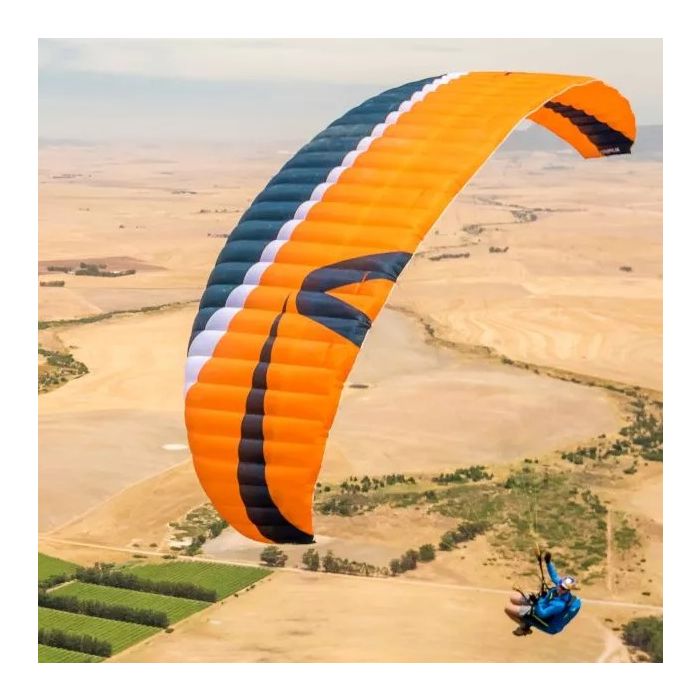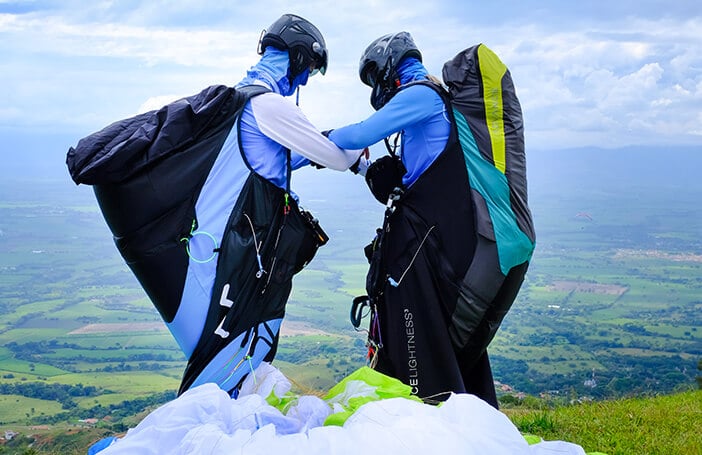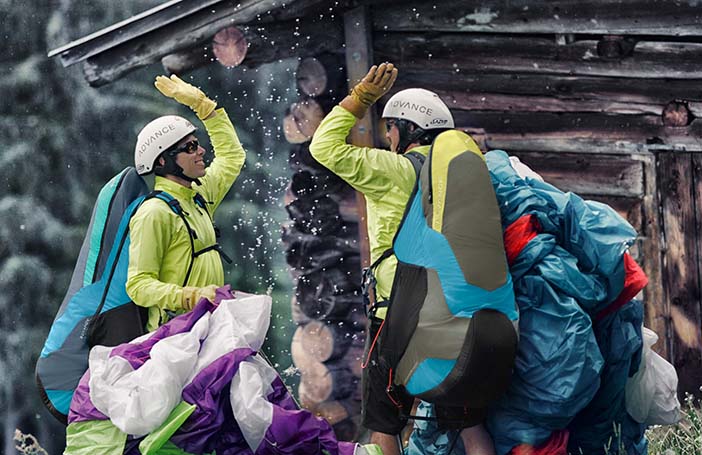Technical Data
| Size |
XS |
S |
M |
L |
XL |
| Cells |
38 |
38 |
38 |
38 |
38 |
| Area flat (m²) |
22.36 |
25.80 |
27.47 |
29.20 |
31.28 |
| Area projected (m²) |
18.88 |
21.79 |
23.21 |
24.66 |
26.42 |
| Wingspan flat (m) |
10.36 |
11.13 |
11.48 |
11.84 |
12.25 |
| Wingspan projected (m) |
8.10 |
8.70 |
8.97 |
9.25 |
9.58 |
| Aspect ratio flat |
4.80 |
4.80 |
4.80 |
4.80 |
4.80 |
| Aspect ratio projected |
3.47 |
3.47 |
3.47 |
3,.7 |
3.47 |
| Glider weight (kg) |
4.6 |
4.8 |
5.0 |
5.2 |
5.4 |
| Certified weight range (kg) |
55-77 |
70-95 |
85-105 |
95-120 |
110-135 |
| Certification (EN/LTF) |
A |
A |
A |
A |
A |
Package
The all-rounder MESCAL5 comes with:
- Glider backpack
- Compression strap
- Inner bag for glider
- Riser bag
- Manual
- Bandana
- Repair Kit
Easy. Flight. Training.
The MESCAL5 is our paraglider for training and your first flights in thermals. Experienced pilots will also appreciate its balanced flight behaviour and its truly simple features – especially when conditions at launch, landing or in the thermals are not easy.
The MESCAL5 is the glider of a new generation because it’s often small things that make a good product even better. We wanted to make the MESCAL5 not just a little, but a lot better than its predecessor, so we applied our treasure trove of experience from four MESCAL generations. We improved a lot of small details, and at least as many other details are completely new. We want to make it even easier for student pilots to enter the third dimension, and for leisure pilots to have even more fun.
Character
How does the mescal glide?
We increased the number of cells slightly compared to its predecessor, while innovative technologies such as the shark nose, double 3D shaping at the leading edge and modern design methods ensure perfect pressure distribution and make the wing even more aerodynamic. The result is more refined handling and a clear performance increase compared with its predecessor.
The MESCAL5 has new ergonomic risers that are well-arranged and sit comfortably in your hand, thus simplifying launch preparations. All lines are from LIROS and are sheathed, sturdy and designed for longevity – as is the Porcher Marine material for top and bottom sails and for the profile ribs.
Did you know already? The MESCAL5 feels great in the air and has exceptionally balanced handling.
Why? Because control line travel is neither too long nor too short, control pressure is neither too high nor too low, and the new MESCAL wing is neither nervous nor too damped. As a result, student pilots and novices immediately feel confident in the air. Advanced pilots are excited about how intuitively the MESCAL5 can be flown. It handles figure-of-eights, full circles and thermals effortlessly. The MESCAL5 is smooth and harmonious, even when the thermals pick up suddenly and get turbulent. This helps novices progress faster while experienced pilots enjoy an afternoon over the summit of their local mountain.
Landing is also pleasantly easy. The traffic pattern is fun to fly because you can fine-tune your speed on the downwind, base and final approach, ensuring a spot landing every time! If you misjudge your spot landing, our Jet Flaps provide you with an additional safety margin to ensure a stall break without surprises.
The only thing left is to wish you a good flight!
Material
| Upper sail |
Porcher Skytex 38g / Porcher Skytex easyfly |
| Lower sail |
Porcher Skytex easyfly |
| Ribs |
Porcher Skytex 40g hard |
| Bands |
Porcher Skytex 40g hard |
| Main lines |
Liros PPSLS 180 |
| Middle lines |
Liros PPSLS 125 |
| Top lines |
Liros PPSLS 65 |
| Brake lines |
Liros DFLP 200/32, PPSLS 65 |
| Risers |
Güth & Wolf 20mm Polyester |
Features
JET FLAPS
Our JET FLAPS extend the green arc as you approach the stall point, which substantially increases safety and also improves climb performance.
RIGID FOIL
The Rigid Foil nylon wires on the leading edge help maintain its shape and ensure constant ram air pressure. Advantages: better takeoff behaviour, more performance and lower canopy weight.
C-WIRES
C-wires are nylon wires sewn into the glider over the anchor points of the C-level lines. Advantages: better load distribution, reduced drag, more performance.
3D-SHAPING
A precise calculation of the leading edge geometry and the installation of an additional strip of fabric reduce wrinkling in this sensitive part of the glider. Advantages: exact wing shape, more performance.
MINI RIBS
Doubling the number of cells at the trailing edge increases its shape stability substantially. Advantage: fewer vortices improve the aerodynamics and with it the performance.
AUTOMATIC SAND RELEASE SYSTEM
The integrated openings on the trailing edge of the stabiliser let sand and dirt fall out automatically. Advantages: material and trailing edge are protected better and the trailing edge is less strained.
SHARK NOSE
Together, with the corresponding wing design, the shark nose technology improves pressure distribution in the canopy substantially. Advantages: much more solid flying feeling and substantial performance gain, especially when gliding on bar.
Liros Only
On the MESCAL5, we rely 100% on the newly developed >>PPSLS-line<< from Liros. This robust Dyneema line guarantees the highest breaking load and minimal stretching despite its small diameter and low weight. That means maximum performance – right from the start!
More information about Liros here.
Downloads
FAQs
What are the glide ratio (L/D), trim and maximum speeds?
We know that this data is interesting for you as a pilot, but for us to publish them would be a bad idea for the following reasons:
1) Performance data is highly dependent on the drag of the pilot and are thefore related to sitting position and harness. The difference between aerodynamically favorable and unfavourable harnesses and sitting positions can be as much as a whole L/D number.
2) Performance increases with the size of the glider. A large glider will always outperform the same glider in a smaller size. So a question about the performance of a glider is always also a question about the size.
3) There is no normed method of testing the performance of paragliders. For example, speed varies with altitude and the associated different air pressure, but also with the total weight of the system.
That means that there simply isn’t THE speed or THE L/D that would allow a serious comparison with another glider. Performance data is dependent on the harness, the size of the glider, the air mass and the total weight.
How do I calculate my take-off weight?
Take-off weight is calculated by adding the weight of the pilot including clothes to the weight of the equipment. The equipment consists of the harness, the reserve chute, the paraglider itself, and any flight instruments and other baggage you may carry (e.g. rucksack, etc.).
Is it OK for me to shorten the brake lines on my skywalk paraglider?
Changing the length of the brake lines can have a negative effect on the flying characteristics and extreme flight behaviour. The paraglider needs a little more lead when flying on speed bar, otherwise the glider could be braked unintentionally, leading to a loss of performance. When performing extreme flying manoeuvres, shortening the brake lines too much can cause complications during recovery from collapses, parachutal stall, etc.
Am I allowed to make modifications to my skywalk paraglider?
No, because the glider is certified the way it is delivered to you. Even the brake line length is part of the trim and must not be changed.
Why shall I not navigate my glider through the C-level
As opposed to gliders with two line levels with which you can change the angle of attack by pulling the rear risers, doing the same on a glider with three line levels causes the profile to deform. This results in a crease forming between levels, which makes the glider more susceptible to collapses. In an emergency, control deflections of several centimetres are possible.
Do the nylon wires in the glider nead any special attention or packing method?
Our nylon wires are flexible and kink resistant, so they won’t break under normal circumstances. But due to the packing volume it is a good idea to lay the Rigid Foils in the leading on top of each other on both sides.
What are JetFlaps and how do they work?
Jet Flaps are a so-called split flap like those seen on a large aeroplane. When the glider is braked, the airflow is routed through the glider, restoring smooth airflow. This extends brake line travel and softens the stall behaviour.
What advantage do the JetFlaps on my skywalk paraglider offer?
Lower flyable minimum airspeed. The speed range is wider and easier to control. The pilot has more time to react when flying near the stall point.

![]()





